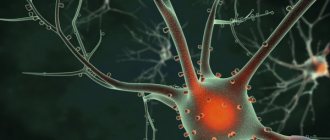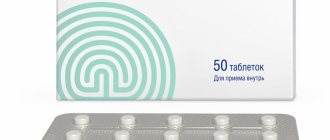Vegetative-vascular dystonia is one of the most mysterious diseases. Firstly, it is functional in nature - in other words, certain functions in the body are disrupted, while there are no visible changes in the organs. They cannot be detected during radiography, ultrasound, CT, MRI and other imaging methods, at the cellular level under a microscope. It is believed that VSD is associated with changes that occur at the subcellular level, and they can only be detected using electron microscopy.
Our expert in this field:
Serebryansky Yuri Evstafievich
Cardiologist, geriatrician, therapist, professor, Honored Doctor of the Russian Federation, Doctor of Medical Sciences
Call the doctor Reviews about the doctor
Secondly, in different sources, vegetative-vascular dystonia can be described as an independent disease, or as a syndrome - a set of specific symptoms. They can occur with arterial hypertension, diseases of internal organs, or exposure to ultra-high frequency electric currents on the body.
Thirdly, it is difficult to find a second such disease that has so many different names. VSD is often called neurocirculatory dystonia, neurocirculatory asthenia, cardioneurosis. It is believed that vegetative-vascular dystonia is closely related to such pathology as panic attacks.
Sometimes the term “Da Costa syndrome” is used as a synonym for VSD (other names are frenocardia, “irritable heart”, “soldier’s heart syndrome”). This pathology was first observed by J.M. Da Costa in young soldiers who participated in the American Civil War. They experienced shortness of breath, a feeling of lack of air, increased heartbeat, heaviness, and pain in the heart area.
Some interesting facts about VSD:
- Vegetative-vascular dystonia is a very common disease. It accounts for up to 50% of all pathologies of the heart and blood vessels.
- Women get sick more often than men.
- Most often, the first manifestations of vegetative-vascular dystonia occur at a young age.
- The development of VSD is based on disruption of the autonomic nervous system - it regulates the functions of internal organs, heart, and blood vessels.
- With VSD, functional disorders occur in all organs and systems, primarily in the cardiovascular.
Treatment of vegetative-vascular dystonia
Treatment of VSD is carried out in three main areas:
- combating the cause of the disease;
- impact on pathological processes that occur in the body;
- general strengthening activities.
There are many causes of vegetative-vascular dystonia, and they are not fully understood, so it is quite difficult to influence them. It is important to lead a healthy lifestyle. You need to eat well, get enough sleep, be in the fresh air, and avoid stress. Sometimes, with mild forms of the disease, this is enough - no other treatment for VSD is needed. Many patients benefit from psychotherapy.
In order to influence the pathological processes that occur in the body during VSD, the doctor can prescribe sedatives (motherwort, valerian), tranquilizers (help cope with fear, anxiety, emotional stress), antidepressants (help fight depression, anxiety), β-blockers (drugs that help reduce the activity of the “stress” part of the autonomic nervous system, cope with increased heartbeat, pain and discomfort in the heart area).
Symptoms of VSD in adults, as well as in children, are very insidious, for the following reasons:
- There are a large number of manifestations of vegetative-vascular dystonia; in different patients they are combined differently, each of them can be strongly or weakly expressed.
- Often the symptoms of vegetative-vascular dystonia resemble other diseases, usually of the cardiovascular system.
- Usually the patient makes many complaints, and during examination and examination no abnormalities are revealed.
Correctly assessing the signs of vegetative-vascular dystonia and establishing the correct diagnosis, not to miss another, more serious disease, will only help with a full, careful examination by a neurologist, a comprehensive examination.
Types of VSD
The nature of the manifestation of signs of VSD directly depends on the condition of the blood vessels. Based on this, the following types of vegetative-vascular dystonia are distinguished:
- hypertensive;
- hypotonic;
- mixed;
- cardiac;
- vagotonic.
But symptoms are extremely rarely present all the time. Most often they are in the nature of attacks. Not all of the signs characteristic of a particular type of vegetative-vascular dystonia always appear. Moreover, this is rare. Typically, patients complain of 2-3 disorders, the presence of which, in combination with the results of the examinations, makes it possible to determine the specific type of vegetative-vascular dystonia.
Based on how VSD occurs, there are 3 degrees of severity of the disorder:
- mild – patients fully retain their ability to work, symptoms of VSD do not cause them significant discomfort, and there are no vegetative crises;
- moderately severe – periods periodically occur during which a person loses ability to work due to exacerbation of vegetative-vascular dystonia and the development of a vegetative crisis;
- severe - a long, persistent course of VSD with frequent periods of exacerbation and crises, which leads to a significant decrease in performance.
Hypertensive type
Patients experience pronounced vascular tone, as well as a persistent increase in blood pressure. Their main complaints focus on the occurrence of:
- rapid heartbeat;
- hot flashes;
- headaches;
- constant fatigue;
- nausea, vomiting, attacks of which are not associated with eating;
- decrease in appetite up to its complete loss;
- sweating (during an attack there is severe sweating of the palms);
- causeless but strong fear;
- flickering “flies” before the eyes.
Hypotonic type
Characterized by low blood vessel tone and low blood pressure. Therefore, patients are often annoyed by:
- episodes of darkening of the eyes;
- a sharp decrease in blood pressure;
- severe weakness;
- loss of consciousness;
- pale skin;
- nausea, heartburn;
- changes in bowel habits (diarrhea or constipation);
- inability to take a full breath.
It can be noted that in patients with VSD of the hypotonic type, the palms and feet are constantly cold.
Mixed type
With this variant of VSD, variability in vascular tone is observed, so blood pressure can fluctuate within a fairly wide range. It can rise sharply to high levels and then suddenly drop to extreme levels.
In such cases, there is a change in the symptoms of VSD, which occurs according to the hypertensive type, with manifestations of VSD of the hypotonic type. This significantly affects the lives of patients, as attacks of weakness, profuse sweating and fainting states are replaced by hot flashes, tachycardia and headaches.
During an attack, there is often a fear of imminent death and the inability to take a full breath, which further aggravates the situation. Pain in the heart area may be present.
Cardiac type
This type of VSD is diagnosed when aching, throbbing pain occurs in the heart area, which does not have a significant effect on a person’s general well-being. They may be accompanied by arrhythmia and profuse sweating, but the examinations carried out do not reveal heart pathologies.
Vagotonic type
For this type of vegetative-vascular dystonia, the occurrence of breathing disorders is typical. Patients often complain of the inability to take a full breath and a feeling of tightness in the chest. In this case, there may be a tendency to lower blood pressure and slow heartbeat. But with the vagotonic type of VSD, there is an increase in salivation and changes in the functioning of the organs of the digestive system.
Symptoms of VSD: what types of disorders occur with this disease?
Symptoms of VSD in adults and children are combined into several groups - syndromes :
- Cardiac syndrome – pain in the heart area.
- Tachycardial syndrome - increased heart rate.
- Hyperkinetic syndrome - inadequate strengthening, activation of the heart.
- Asthenic syndrome – chronic fatigue, fatigue, frequent mood swings.
- Autonomic dystonia syndrome is a disorder of autonomic functions (impaired functioning of the cardiovascular system, internal organs, glands).
- Respiratory distress syndrome is a dysfunction of the respiratory system.
This division of signs of vegetative-vascular dystonia is conditional.
Prevention
Preventive measures for vegetative-vascular dystonia help increase the body's resistance to stress and strengthen the immune system. They are used not only to prevent the disease, but also as an addition to the main therapy. Doctors recommend:
- normalize the work and rest schedule, prevent overtime;
- eliminate psycho-emotional irritants as much as possible, ensure a comfortable psychological atmosphere at home;
- sleep at least 8 hours every day;
- regularly walk in the fresh air (at least 1 hour a day);
- engage in amateur sports to strengthen the body: aerobic exercise (biking, race walking) and swimming have a good effect.
Proper nutrition is also important. Recommended:
- create a diet in accordance with the principles of a healthy diet with sufficient amounts of proteins, fats, carbohydrates and microelements;
- do not exceed the daily calorie intake corresponding to age, gender and lifestyle;
- drink at least 1.5-2 liters of clean water per day;
- regularly choose foods containing large amounts of magnesium and potassium (avocado, dried apricots, bananas, almonds, broccoli, peas, spinach); they help normalize the functioning of the cardiovascular system;
- minimize the consumption of black tea, coffee, spicy, fatty, smoked foods;
- exclude alcohol.
What are the most common symptoms of vegetative-vascular dystonia?
Among the fair sex, the disease is more common, but the symptoms of VSD in women and men differ little. Most often, the disease has the following manifestations:
- Heartache . With vegetative-vascular dystonia, they can be different: stitching, aching, bursting, burning. Sometimes they last literally one moment (“the heart stabbed”), and in other cases they last for hours, days. Usually pain is provoked by overwork, weather changes, nervous tension, and alcohol consumption.
- Anxiety, worsening mood, weakness, restlessness are symptoms that often accompany heart pain. If the pain attack is severe, fear, increased heart rate, and a feeling of lack of air occur.
- Shortness of breath . Typically, patients with vegetative-vascular dystonia complain to a neurologist that they are worried about “shortness of breath,” but in fact, by this word they mean frequent shallow breathing. There is a feeling as if breathing is difficult, you want to take a deep breath.
- Feeling of a lump in the throat . This symptom is quite painful; a person feels as if “something is squeezing his throat,” and he is bothered by dizziness, weakness, anxiety, and fear of death. I want to open the window wider and go outside.
- Unpleasant sensations in the heart . This may be a feeling of increased heartbeat, as if the heart is “jumping out” or “turning over.”
- Weakness . Characteristic signs of vegetative-vascular dystonia: constant fatigue, drowsiness, low mood, decreased performance.
- Vascular disorders . Many patients with VSD note fluctuations in blood pressure. Headaches, dizziness, coldness, chilliness in the arms and legs occur.
- Feeling unwell when the temperature in the room or outside is high or low.
- Decreased performance . Both mental and physical. The patient gets tired quickly.
- Disorders of the digestive system . Symptoms of vegetative-vascular dystonia include nausea and vomiting, belching, hiccups, and abdominal pain. Appetite may worsen, causing the patient to lose weight.
VSD can begin in different ways. In some cases, all the symptoms appear at once, they are very pronounced. They can also grow gradually - a person even finds it difficult to say exactly when he realized that he was sick.
Exacerbation of VSD and features of the course
Despite the fact that VSD is not an independent disease, but only combines a set of symptoms characteristic of emotional and psychological disorders, it can lead to the development of diseases of organs and systems. Against the background of imbalance, the following may develop:
- bronchial asthma;
- hypertension;
- stomach ulcer;
- heart diseases.
The disorder occurs in different ways: in the form of constant deviations in the functioning of organs and systems or pronounced short-term attacks. Often the course of dystonia is unnoticed until a stressful situation occurs, when its symptoms become apparent.
Exacerbations can be seasonal or occur in response to physiological changes. For example, in women, exacerbation can occur during pregnancy or during menstruation.
In winter, the syndrome becomes more active due to decreased immunity and frequent infectious diseases. In spring - hypovitaminosis and the body's natural need for sunlight, a deficiency of which most of us experience throughout the winter. In summer, the body is negatively affected by heat; in autumn, there is a general dreary picture outside the window, full of grayness and depressive notes.
“External reasons, of course, can provoke an exacerbation of VSD,” explains neurologist Olesya Bryukhanova. “But most often the cause is stress, mental and emotional stress.”
Signs of vegetative-vascular dystonia during a crisis
Patients may experience crises - usually at night, signs of VSD appear such as chills, body tremors, dizziness, a feeling of shortness of breath, sweating, and inexplicable fear. This condition can last from 20 minutes to 3 hours and occur from 3 times a week to 1 time a month. After a crisis, a person experiences weakness, anxiety, and heart pain.
We will call you back
Message sent!
expect a call, we will contact you shortly
Treatment of VSD symptoms in adults
Treatment of VSD symptoms is carried out individually in each case. They use sedatives, antidepressants, tranquilizers, other medications, and general restorative treatment.
You should not self-medicate. See your doctor. Symptoms of vegetative-vascular dystonia do not lead to serious complications, but cause a lot of problems and reduce performance. They may be hiding a more serious illness.
Make an appointment with a neurologist at the medical center International Clinic Medica24 - at any time of the day
In each case, treatment for vegetative-vascular dystonia is selected individually, after examination by a doctor and a comprehensive examination. If the symptoms of VSD are caused by another disease, it must be treated as well.
Tired of going to doctors? Do you undergo one examination after another, each time it turns out that everything is normal, but your symptoms continue to bother you? Visit a neurologist at the Medical Center International Clinic Medica24. Here you will be given a reliable diagnosis and prescribed the correct treatment. Call us any day of the week, at any time: +7 (495) 230-00-01
The causes of VSD in adults and children have not been fully established. It is believed that the disease occurs under the influence of various factors; in different people their effects are expressed to varying degrees, and they are combined in different ways. That is why the manifestations of vegetative-vascular dystonia are so diverse; it is difficult to find two patients in whom the disease would proceed in exactly the same way.
A doctor can judge the causes of VSD only approximately; it is much more important to correctly assess the symptoms and prescribe effective treatment.
Causes of vegetative-vascular dystonia in adults
The main cause of the disease is overstrain of the nervous system. The disorder occurs against a background of chronic stress, constant fatigue, lack of normal rest, and an unhealthy lifestyle. It has been established that alcohol abuse plays an important role in its development.
There are no official statistics on how many people in our country and the world suffer from this problem. But there is evidence that it occurs four times more often in women than in men. The reason for this is the greater emotional instability of women, susceptibility to the influence of hormones, a tendency to take everything to heart and experience any events much more acutely than men.
According to Olesya Bryukhanova, these data are not entirely correct, since the frequency of VSD in childhood among boys and girls is approximately the same. But the older children get, the more pronounced the differences in their behavior become. After all, boys, unlike girls, cannot show weakness and tears, they cannot demonstrate gentleness and sympathy. Therefore, their emotional problems can result in panic attacks and aggression.
The imbalance of the nervous system, established in childhood, only worsens in adolescence, and the nervous tension with which a man is forced to live persists for years. A person may suffer from attacks of arrhythmia, headaches due to changes in weather, or due to intestinal disorders. But it is extremely rare that such “nonsense” is discussed with a doctor or even just discussed with loved ones. Men tend to hide these symptoms, try to ignore them, or treat them with a “proven folk remedy” - alcohol, which not only does not alleviate the condition, but also leads to aggravation of the symptoms of VSD.
pixabay.com/
Main causes of VSD in adults
Representatives of the fair sex suffer from this disease more often, however, the causes of vegetative-vascular dystonia in women and men do not differ:
Conditions that predispose to vegetative-vascular dystonia (increase the likelihood of developing VSD):
- Features of the structure and functioning of the body;
- Features of personality, human psychology;
- Living in unfavorable social and economic conditions;
- Hormonal changes (puberty in adolescents, menopause in women).
Factors that can provoke the occurrence of VSD:
- Severe, chronic stress, nervous shock;
- Overwork;
- Exposure to radiation;
- Passion for alcohol;
- Pregnancy;
- Abortion;
- Ovarian dysfunction in women;
- Chronic inflammatory diseases;
- Exacerbations of diseases.
Take care of yourself, book a consultation now
Message sent!
expect a call, we will contact you shortly
How do the causes of VSD lead to disease: what happens in the body?
The factors listed above lead to disruption of the autonomic nervous system, which regulates the functioning of internal organs, blood vessels, and glands. As a rule, the basis of all disorders is damage to the hypothalamus , a formation in the brain that is the “main conductor” of many functions in the body.
As a result, the work of the parts of the autonomic nervous system becomes inconsistent, water-salt metabolism and the functions of some biologically active substances are disrupted. First of all, with VSD, this affects the functioning of the cardiovascular system. The supply of oxygen to the body's tissues is disrupted - this becomes critical during physical activity. The heart and blood vessels begin to respond to stress inadequately, “incorrectly.”
Depending on what factors are the main cause of vegetative-vascular dystonia, different forms of the disease are distinguished:
- Neurotic (psychogenic).
- Caused by physical overexertion.
- Infectious-toxic.
- Hereditary.
- Caused by physical impacts and occupational hazards.
- Mixed.
This division is quite arbitrary. Most often, one can only make an assumption about the leading cause of VSD.
An experienced neurologist will be able to correctly understand the causes of vegetative-vascular dystonia, prescribe a comprehensive examination and proper treatment. Perhaps, under the manifestations of “VSD” a more serious disease is hidden. Make an appointment with a doctor: +7 (495) 230-00-01
Often, diagnosing VSD is difficult even for an experienced doctor. The disease can occur in different ways. The patient experiences various symptoms, and no abnormalities are found during the examination. Often, in order to diagnose vegetative-vascular dystonia, it is necessary to exclude a lot of other pathologies.
Therapy for VSD
Is VSD treatable? This question worries hundreds of people, because the disorder causes many problems and significantly worsens the quality of life.
With VSD, it is important to eliminate emotional stress and streamline your daily schedule. Treatment of VSD in adults is a complex therapy that includes various methods
However, before deciding how to deal with VSD, you need to make a correct diagnosis.
Patients with signs of vegetative-vascular dystonia have to go through many specialists before they are given a final diagnosis. Depending on the symptoms, the attending physician prescribes a consultation with specialists, as well as tests.
How to defeat VSD? If you have vegetative-vascular dystonia, you can get rid of it forever only if you follow certain rules. When a diagnosis is made, treatment is carried out by a neurologist. It is he who develops a treatment strategy, which may include the following measures:
- Examinations for concomitant diseases and their treatment by specialists.
- In moments of crisis, the patient is prescribed medications to relieve symptoms.
- Also, in order to get rid of VSD, the patient often needs to take sedatives.
- Physiotherapy is an integral part of treatment for VSD; it perfectly combats the manifestation of unpleasant symptoms in the treatment of vegetative-vascular dystonia.
Work and rest schedule. Each person has his own reserve of strength. Many patients, asking the question of how to cure VSD, do not even think about the fact that they themselves provoke the development of crises by overstraining their body. All people, regardless of whether they have VSD symptoms or not, need quality rest. Mental and physical stress is one of the factors in the development of abnormalities in the functioning of the nervous system. Sleep should last at least 8 hours a day.
Passive lifestyle. It is impossible to cure vegetative distance by sitting in a chair all day. With a sedentary lifestyle, all human organs suffer, because muscles weaken, structural changes occur, organs are displaced, the spine and, as a result, the nervous system suffer. Daily exercise can solve this problem. The nerve fibers will receive the necessary nutrition, and the muscles will gain tone, which will ensure good health.
Emotional peace. Effective treatment of dystonia is impossible if a person is constantly under stress. Any nervous tension can turn into a crisis and a significant deterioration in the condition. A huge number of negative facts that we learn from the media form fears, anxiety, excitability and depression in us. Any scandals, tension in family relationships and at work also have a negative impact on health. Of course, life without worries is not possible, but you need to learn to control your emotions and, if necessary, visit a psychotherapist.
Nutrition
Before wondering how to treat vegetative-vascular dystonia, you need to pay attention to your diet and eating schedule
Many people underestimate the importance of healthy food. We are used to eating in fits and starts, eating fast food and neglecting healthy food.
However, we must remember that nutrition is the only way to a healthy life. We are what we eat. This is a truth that every person should remember. A lack of vitamins, microelements and nutrients can cause various disorders, including nervous system failures. In adults, treatment also involves complete cessation of bad habits.
We are used to eating in fits and starts, eating fast food and neglecting healthy food. However, we must remember that nutrition is the only way to a healthy life. We are what we eat. This is a truth that every person should remember. A lack of vitamins, microelements and nutrients can cause various disorders, including nervous system failures. In adults, treatment also involves complete cessation of bad habits.
Diagnosis of VSD in adults: instrumental studies and analyzes
If you suspect vegetative-vascular dystonia, a neurologist may prescribe the following studies and laboratory tests:
- General and biochemical blood tests . With vegetative-vascular dystonia, no pathological changes are detected in them. They are needed in order to exclude inflammatory diseases, for example, rheumatic carditis .
- Chest X-ray . In the pictures, the heart, aorta and other large vessels have normal sizes with VSD - this indicates that there are no heart valve defects.
- Electrocardiography . During the study, changes are revealed that may resemble coronary heart disease. However, they are not stable and change during tests with physical activity and the administration of medications. Sometimes, with vegetative-vascular dystonia, extrasystoles - extraordinary contractions of the heart muscle. However, they do not arise due to pathology of the heart, but are caused by a mismatch in the functioning of the nervous system.
- Ultrasound of the heart . Allows you to eliminate valve defects. With VSD, mitral valve prolapse may be detected.
As can be seen from the list, the diagnosis of VSD is aimed primarily not at detecting any changes characteristic of a given disease, but at excluding other pathologies.
We are proud of the team of neurologists - experienced professionals - that we managed to assemble at the Medical Center International Clinic Medica24. You will be carefully examined, the doctor will not miss anything, because all our doctors work according to the same standards developed by experts. Clinic administrators are ready to take your call at any time of the day.
Get a consultation with a doctor
Message sent!
expect a call, we will contact you shortly
Criteria for diagnosing VSD
In order to reliably diagnose vegetative-vascular dystonia, the doctor must detect symptoms that are often found in this disease and exclude other pathologies. Neurologists are usually guided by the following criteria:
- A patient with VSD presents many different complaints. First of all, they relate to disruption of the cardiovascular system.
- The patient suffers from the disease for quite a long time. Exacerbations occur periodically, during which the symptoms intensify.
- There are no serious complications, heart failure.
- There are a lot of complaints, but during the examination one gets the impression that the person is healthy.
- The diagnosis of VSD cannot be made if the following signs are present: an increase in heart size, heart murmurs, pronounced changes in the ECG, an inflammatory process in the body (detected by the results of general and biochemical blood tests), heart failure.
In these cases, it is necessary to continue the diagnosis and look for the true cause of “vegetative-vascular dystonia”.
Diagnostics
To diagnose and prescribe treatment for VSD, you must consult a neurologist. Before the consultation, it is best to make a detailed list of complaints. This will help the specialist not only detect VSD, but also suggest what caused its development. The doctor will definitely conduct a thorough survey, during which he will also find out the presence and nature of the prerequisites for the development of vegetative-vascular dystonia.
Then the neurologist proceeds to the examination. The doctor assesses the condition of the skin, measures the pulse, blood pressure, sometimes using an orthostatic test (2 measurements are taken: one in a lying position, the second after taking up a vertical position), listens to the lungs and heart. To assess the activity of the sympathetic and parasympathetic autonomic nervous system, he may pass the end of the hammer handle over the skin.
After completing the examination and assuming the presence of VSD, the neurologist must prescribe a set of studies that will help detect or confirm existing assumptions about the causes of the development of the disorder. For this purpose, patients are prescribed:
- UAC and OAM;
- blood sugar test;
- blood test for TSH, T3 and T4 (thyroid hormones);
- biochemical blood test to determine the concentration of potassium, cholesterol, creatinine, urea and other compounds;
- ECG;
- fluorography of the chest organs;
- rheoencephalography;
- MRI;
- Ultrasound scanning of neck vessels;
- EEG.
In our clinic, you can also learn in more detail about the composition of your body and the state of the vascular system, which is involved in the blood supply to internal organs, skeletal muscles, and the brain. Our experienced doctors will explain the data obtained to you in detail. Bioimpendansometry calculates the ratio of fat, muscle, bone and skeletal mass, total fluid in the body, and basal metabolic rate. The intensity of recommended physical activity depends on the state of muscle mass. Metabolic processes, in turn, affect the body's ability to recover. Based on the indicators of active cell mass, one can judge the level of physical activity and nutritional balance. This simple and quick test helps us identify disturbances in the endocrine system and take the necessary measures. In addition, it is also very important for us to know the condition of blood vessels for the prevention of diseases such as heart attacks, hypertension, heart failure, diabetes and much more. Angioscan allows you to determine such important indicators as the biological age of blood vessels, their stiffness, stress index (which indicates heart rate), and blood oxygen saturation. Such screening will be useful for men and women over 30, athletes, those undergoing long-term and severe treatment, as well as everyone who monitors their health.
Differential diagnosis of VSD
Differential diagnosis of vegetative-vascular dystonia most often has to be carried out with the following diseases: coronary heart disease (CHD), infectious-allergic myocarditis, rheumatism, cardiomyopathies.
During diagnosis, a neurologist focuses on the patient’s complaints, examination data, examinations, and test results. All symptoms must be carefully assessed.
The international clinic Medica24 employs experienced neurologists and uses new, modern diagnostic equipment. This allows you to establish a reliable diagnosis as quickly as possible and immediately begin effective treatment. We have medical assistance available around the clock.
The material was prepared by a cardiologist, geriatrician, therapist, professor, Honored Doctor of the Russian Federation, Doctor of Medical Sciences at the international clinic Medica24 Yuri Evstafievich Serebryansky.











